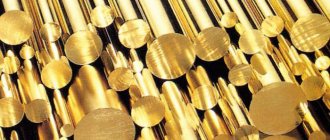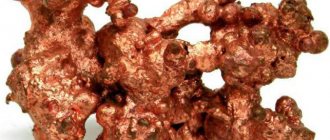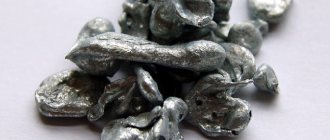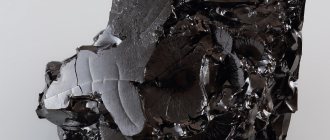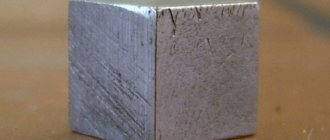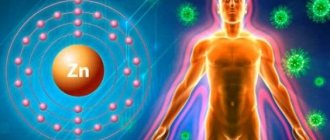Table of molar masses of chemical elements.
Molar mass is a characteristic of a substance, the ratio of the mass of a substance to its quantity.
In the International System of Units (SI), the unit of measurement for molar mass is kilogram per mole (Russian designation: kg/mol; international: kg/mol). Historically, molar mass was typically expressed in g/mol.
The molar mass is numerically equal to the mass of one mole of a substance, that is, the mass of a substance containing a number of particles equal to Avogadro’s number (NA = 6.022 140 76⋅1023 mol−1).
Molar mass, expressed in g/mol, is numerically the same as molecular mass (absolute molecular mass), expressed in a. e.m., and relative molecular weight.
In turn, molecular mass is the mass of a molecule. There are absolute molecular mass (usually expressed in atomic mass units, amu) and relative molecular mass - a dimensionless value equal to the ratio of the mass of a molecule to 1/12 of the mass of a carbon .
Molar mass is denoted by M.
It must be borne in mind that the molar masses of chemical elements and the simple substances that they form are not the same thing.
History of discovery.
It is known that zinc has been used as a composite material since ancient times. The very first finds of brass objects (brass is an alloy of copper + zinc) date back to 1500 BC. (excavations were carried out in Palestine). Mentions of brass smelting processes can be found in the works of Aristotle and Homer, Pliny (the Elder). Ancient treatises describe various casting methods. One of them examines in detail the method of preparing brass by reducing a special zinc stone (the so-called cadmium) with coal in the presence of a copper component. It was especially noted in the scientific work that adding zinc to the alloy can solve several issues at once:
- change in the color scheme of the finished copper product (as a result of lightening, the shade changed to “golden”),
- the mechanical properties of the finished melted product changed dramatically for the better, ductility and elasticity increased, and the resulting alloy could be rolled into sheets. At the same time, by changing the percentage ratio of zinc to copper in brass, it was possible to change the range of mechanical characteristics.
The first mention of the process of obtaining zinc metal was found in India (5th century BC). Also, the method of smelting “fake silver” can be found in the historical treatises of Strabop (Rome, 60 - 20 BC). At the end of the 13th century, the famous traveler Marco Polo in his notes described in detail the process of obtaining metallic zinc, which he observed in Persia. Back in the 16th century, Paracelsus and Agricola tried to organize zinc smelting production in their laboratory. However, the attempts ended in failure.
Until the mid-18th century, pure zinc was considered rare in Europe. It was mainly imported from the countries of the East, China, and India.
In 1738, Champion W. developed and patented a method for producing metallic zinc by distillation.
In 1743, in the city of Bristol, he built the first plant in Europe for the production of metallic zinc.
The word "zinc" first appears in the writings of Paracelsus, who called this metal the word "zincum" or "zinken" in the book Liber Mineralium. The word probably comes from the German Zinke, meaning "tooth" (zinc metal crystallites are like needles).
Marggraf A.S. in 1746 in Germany he published a new method for obtaining pure metallic zinc. The essence of the method was that a mixture of coal and zinc oxide was calcined in special vessels without air access, followed by cooling in a refrigerator. As a result, the zinc vapor condensed, forming pure zinc. Retorts made of refractory clay were used as sealed vessels for experiments.
In 1805, another method of producing zinc was invented - rolling in the temperature range from 100-150 degrees C. The developers of the new technological method were Ch. Hobson and Sylvester Ch. (Sheffield).
The electrolytic casting method began to be used in 1915 (Canada, USA).
Table of molar masses of chemical elements (part 1):
| Atomic number | Chemical element | Symbol | Molar mass |
| 1 | Hydrogen | H | 1.00784-1.00811 amu (g/mol) |
| 2 | Helium | He | 4.002602(2) amu (g/mol) |
| 3 | Lithium | Li | 6.938-6.997 amu (g/mol) |
| 4 | Beryllium | Be | 9.012182(3) amu (g/mol) |
| 5 | Bor | B | 10.806-10.821 amu (g/mol) |
| 6 | Carbon | C | 12.0096-12.0116 amu (g/mol) |
| 7 | Nitrogen | N | 14.00643-14.00728 amu (g/mol) |
| 8 | Oxygen | O | 15.99903-15.99977 amu (g/mol) |
| 9 | Fluorine | F | 18.998403163(6) a.m.u. (g/mol) |
| 10 | Neon | Ne | 20.1797(6) amu (g/mol) |
| 11 | Sodium | Na | 22.98976928(2) amu (g/mol) |
| 12 | Magnesium | Mg | 24.304-24.307 amu (g/mol) |
| 13 | Aluminum | Al | 26.9815386(8) amu (g/mol) |
| 14 | Silicon | Si | 28.084-28.086 amu (g/mol) |
| 15 | Phosphorus | P | 30.973762(2) amu (g/mol) |
| 16 | Sulfur | S | 32.059-32.076 amu (g/mol) |
| 17 | Chlorine | Cl | 35.446-35.457 amu (g/mol) |
| 18 | Argon | Ar | 39.948(1) amu (g/mol) |
| 19 | Potassium | K | 39.0983(1) amu (g/mol) |
| 20 | Calcium | Ca | 40.078(4) amu (g/mol) |
| 21 | Scandium | Sc | 44.955912(6) amu (g/mol) |
| 22 | Titanium | Ti | 47.867(1) amu (g/mol) |
| 23 | Vanadium | V | 50.9415(1) amu (g/mol) |
| 24 | Chromium | Cr | 51.9961(6) amu (g/mol) |
| 25 | Manganese | Mn | 54.938045(5) amu (g/mol) |
| 26 | Iron | Fe | 55.845(2) amu (g/mol) |
| 27 | Cobalt | Co | 58.933194(4) amu (g/mol) |
| 28 | Nickel | Ni | 58.6934(4) amu (g/mol) |
| 29 | Copper | Cu | 63.546(3) amu (g/mol) |
| 30 | Zinc | Zn | 65.38(2) amu (g/mol) |
Prevalence in nature and production
Zinc is a very common element. Natural zinc compounds include ZnS sulfide (two polymorphs: wurtzite and sphalerite ), also known as zinc blende; carbonate ZnCO3 - zinc spar.
Sphalerite, zinc blende
To obtain pure zinc, the ore is first roasted and then the resulting oxide is reduced with coal:
$$\ce{2ZnS + 3O_2 -> 2ZnO + 2SO_2}$$ $$\ce{ZnCO_3 -> ZnO + CO_2}$$ $$\ce{ZnO + C -> Zn + CO}$$
Table of molar masses of chemical elements (part 2):
| 31 | Gallium | Ga | 69.723(1) amu (g/mol) |
| 32 | Germanium | Ge | 72.630(8) amu (g/mol) |
| 33 | Arsenic | As | 74.92160(2) amu (g/mol) |
| 34 | Selenium | Se | 78.96(3) amu (g/mol) |
| 35 | Bromine | Br | 79.901-79.907 amu (g/mol) |
| 36 | Krypton | Kr | 83.798(2) amu (g/mol) |
| 37 | Rubidium | Rb | 85.4678(3) amu (g/mol) |
| 38 | Strontium | Sr | 87.62(1) amu (g/mol) |
| 39 | Yttrium | Y | 88.90585(2) amu (g/mol) |
| 40 | Zirconium | Zr | 91.224(2) amu (g/mol) |
| 41 | Niobium | Nb | 92.90638(2) amu (g/mol) |
| 42 | Molybdenum | Mo | 95.96(2) amu (g/mol) |
| 43 | Technetium | Tc | 97.9072 amu (g/mol) |
| 44 | Ruthenium | Ru | 101.07(2) amu (g/mol) |
| 45 | Rhodium | Rh | 102.90550(2) amu (g/mol) |
| 46 | Palladium | Pd | 106.42(1) amu (g/mol) |
| 47 | Silver | Ag | 107.8682(2) amu (g/mol) |
| 48 | Cadmium | Cd | 112.411(8) amu (g/mol) |
| 49 | Indium | In | 114.818(1) amu (g/mol) |
| 50 | Tin | Sn | 118.710(7) amu (g/mol) |
| 51 | Antimony | Sb | 121.760(1) amu (g/mol) |
| 52 | Tellurium | Te | 127.60(3) amu (g/mol) |
| 53 | Iodine | I | 126.90447(3) amu (g/mol) |
| 54 | Xenon | Xe | 131.293(6) amu (g/mol) |
| 55 | Cesium | Cs | 132.9054519(2) amu (g/mol) |
| 56 | Barium | Ba | 137.327(7) amu (g/mol) |
| 57 | Lanthanum | La | 138.90547(7) amu (g/mol) |
| 58 | Cerium | Ce | 140.116(1) amu (g/mol) |
| 59 | Praseodymium | Pr | 140.90765(2) amu (g/mol) |
| 60 | Neodymium | Nd | 144.242(3) amu (g/mol) |
Zinc alloys
As mentioned above, the most common zinc alloy is brass. It has been known since ancient times and is still actively used by people to this day. What is he like?
Brass is copper and zinc that combine harmoniously with several other metals to add extra shine, strength and toughness to the alloy. Zinc is included as an alloying element, copper as the main one. The color of the material is yellow and shiny, but can turn black in the open air in a humid environment. The melting point is about 950 °C, it can vary depending on the zinc content (the more it is, the lower the temperature).
The material is well rolled into sheets, pipes, and contact welded. It has good technical characteristics, so the following elements are made from it:.
- Machine parts and various technical devices.
- Sleeves and stamped products.
- Nuts, bolts, pipes.
- Fittings, bushings, anti-corrosion parts for various types of transport.
- Clock details.
Most of the metal we are considering mined in the world goes specifically to the production of this alloy.
Another type of intermetallic compound is zinc antimonide. Its formula is Zn4Sb3. It is also an alloy that is used as a semiconductor in transistors, thermal imagers, and magnetoresistive devices.
It is obvious that the use of zinc and its compounds is very wide and almost everywhere. This metal is as popular as copper and aluminum, silver and gold, manganese and iron. Its importance is especially great for technical purposes as an anti-corrosion material. After all, various alloys and products are coated with zinc to protect them from this destructive natural process.
Table of molar masses of chemical elements (part 3):
| 61 | Promethium | Pm | 144.9127 amu (g/mol) |
| 62 | Samarium | Sm | 150.36(2) amu (g/mol) |
| 63 | Europium | Eu | 151.964(1) amu (g/mol) |
| 64 | Gadolinium | Gd | 157.25(3) amu (g/mol) |
| 65 | Terbium | Tb | 158.92535(2) amu (g/mol) |
| 66 | Dysprosium | Dy | 162,500(1) amu (g/mol) |
| 67 | Holmium | Ho | 164.93032(2) amu (g/mol) |
| 68 | Erbium | Er | 167.259(3) amu (g/mol) |
| 69 | Thulium | Tm | 168.93421(2) amu (g/mol) |
| 70 | Ytterbium | Yb | 173.045(10) amu (g/mol) |
| 71 | Lutetium | Lu | 174.9668(1) amu (g/mol) |
| 72 | Hafnium | Hf | 178.49(2) amu (g/mol) |
| 73 | Tantalum | Ta | 180.94788(2) amu (g/mol) |
| 74 | Tungsten | W | 183.84(1) amu (g/mol) |
| 75 | Rhenium | Re | 186.207(1) amu (g/mol) |
| 76 | Osmium | Os | 190.23(3) amu (g/mol) |
| 77 | Iridium | Ir | 192.217(3) amu (g/mol) |
| 78 | Platinum | Pt | 195.084(9) amu (g/mol) |
| 79 | Gold | Au | 196.966569(4) amu (g/mol) |
| 80 | Mercury | Hg | 200.592(3) amu (g/mol) |
| 81 | Thallium | Tl | 204.382-204.385 amu (g/mol) |
| 82 | Lead | Pb | 207.2(1) amu (g/mol) |
| 83 | Bismuth | Bi | 208.98040(1) amu (g/mol) |
| 84 | Polonium | Po | 208.9824 amu (g/mol) |
| 85 | Astatine | At | 209.9871 amu (g/mol) |
| 86 | Radon | Rn | 222.0176 amu (g/mol) |
| 87 | France | Fr | 223.0197 amu (g/mol) |
| 88 | Radium | Ra | 226.0254 amu (g/mol) |
| 89 | Actinium | Ac | 227.0278 amu (g/mol) |
| 90 | Thorium | Th | 232.03806(2) amu (g/mol) |
| 91 | Protactinium | Pa | 231.03588(2) amu (g/mol) |
| 92 | Uranus | U | 238.02891(3) amu (g/mol) |
| 93 | Neptunium | Np | 237.0482 amu (g/mol) |
| 94 | Plutonium | Pu | 244.0642 amu (g/mol) |
| 95 | Americium | Am | 243.061375 amu (g/mol) |
| 96 | Curium | Cm | 247.0703 amu (g/mol) |
| 97 | Berkelium | Bk | 247.0703 amu (g/mol) |
| 98 | Californium | Cf | 251.0796 amu (g/mol) |
| 99 | Einsteinium | Es | 252.083 amu (g/mol) |
| 100 | Fermium | Fm | 257.0951 amu (g/mol) |
| 101 | Mendelevium | MD | 258.1 amu (g/mol) |
| 102 | Nobelium | No | 259.1009 amu (g/mol) |
| 103 | Lawrence | Lr | 266 amu (g/mol) |
| 104 | Rutherfordium (Kurchatovium) | Rf | 267 amu (g/mol) |
| 105 | Dubnium (Nilsborium) | Db | 268 amu (g/mol) |
| 106 | Seaborgium | Sg | 269 amu (g/mol) |
| 107 | Borius | Bh | 270 amu (g/mol) |
| 108 | Hassiy | Hs | 269 a. e.m. (g/mol) |
| 109 | Meitnerium | Mt | 278 a. e.m. (g/mol) |
| 110 | Darmstadt | Ds | 281 a. e.m. (g/mol) |
Demand factor 7,042
Physical properties
Several characteristics can be identified.
- Color: silver blue.
- Density - 7.13 g/cm3.
- Melting point - 420 °C (belongs to the group of low-melting metals).
- Under normal conditions it is a fragile substance.
- Boiling point - 906 oC.
- When heated to 100-150 °C, malleability and ductility increase, making wire and rolling into foil is possible.
- Above 200 °C it is easily ground into gray powder, losing its plasticity.
- He is an excellent guide.
- Thermal conductivity is good, as is the heat capacity.
Such physical parameters allow the metal to be used in connections with other elements. For example, a widely known zinc alloy is brass.
Biological role
What is zinc from a medical and biological point of view? Does it matter for the life of organisms and how great is it? It turns out that zinc ions simply must be present in living beings. Otherwise, the deficit will lead to the following consequences:
- anemia;
- decreased insulin;
- allergies;
- weight loss and memory;
- fatigue;
- depression;
- blurred vision;
- irritability and others.
The main places of concentration of zinc ions in the human body are the pancreas, liver and muscles. It is also this metal that is part of most enzymes (for example, carbonic anhydrase). Therefore, most catalytic reactions occur with the participation of zinc.
What exactly do ions do?
- Participate in the synthesis of male hormones and seminal fluid.
- Promotes the absorption of vitamin E.
- Participate in the breakdown of alcohol molecules in the body.
- They are direct participants in the synthesis of many hormones (insulin, growth hormone, testosterone and others).
- Takes part in hematopoiesis and healing of damaged tissues.
- Regulates the secretion of the sebaceous glands, maintains normal hair and nail growth, and promotes regeneration processes in the skin.
- It has the ability to eliminate toxins from the body and strengthen the immune system.
- Affects the formation of taste sensations, as well as the sense of smell.
- Takes part in transcription processes, vitamin A metabolism, nucleic synthesis and decay.
- It is a participant in all stages of cell growth and development, and also accompanies the process of gene expression.
All this once again proves how important this metal is. Its role in biological systems was clarified only in the 20th century. Many troubles and illnesses in the past could have been avoided if people had known about treatment with zinc-based drugs.
How can you maintain the required amount of this element in the body? The answer is obvious. It is necessary to consume foods containing zinc. The list can be long, so we will indicate only those with the maximum number of the element in question:
- nuts and seeds;
- legumes;
- meat;
- seafood, especially oysters;
- cereals and bread;
- milk products;
- greens, vegetables and fruits.
Reactions in which Zinc Hydroxide is involved
- Zn(OH)2 + 2NaOH -> Na2[Zn(OH)4]
- Na2[Zn(OH)4] -> Zn(OH)2″|v” + 2NaOH
- Na2[Zn(OH)4] + 2HCl -> 2NaCl + Zn(OH)2″|v” + 2H2O
- Na2[Zn(OH)4] + CO2 -> Na2CO3 + Zn(OH)2″|v” + H2O
- {M}(OH)2 + H2{X} = {M}{X} + 2H2O, where M =
Mg Ca Ba Sr Cu Zn>;>X = SO4 SO3 CO3
Sources
- https://FB.ru/article/181833/chto-takoe-tsink-formula-soedineniya-tsinka-primenenie-tsinka
- https://xn--80aaafltebbc3auk2aepkhr3ewjpa.xn--p1ai/gidroksid-tsinka-harakteristika-svoystva-i-poluchenie-himicheskie-reaktsii/
- https://dic.academic.ru/dic.nsf/ruwiki/869017
- https://ru.wikipedia.org/wiki/%D0%93%D0%B8%D0%B4%D1%80%D0%BE%D0%BA%D1%81%D0%B8%D0%B4_%D1 %86%D0%B8%D0%BD%D0%BA%D0%B0
- https://allbreakingnews.ru/gidroksid-cinka-xarakteristika-svojstva-i-poluchenie-ximicheskie-reakcii/
- https://chemiday.com/ru/encyclopedia/znoh2
- https://charchem.org/ru/subst-ref/?id=2564
Top 7 Health Benefits of Zinc
- 1 Increases immunity. Strengthens the immune response and can act as an antioxidant - protect against cancer, diabetes, chronic heart disease. Just 45 mg of gluconate reduces inflammatory markers and the incidence of infections in older adults. [13, 14, 15, 16]
- 2 Speeds up recovery from colds. Zinc can prevent the proliferation of rhinovirus - prevent it from penetrating the mucous membranes of the throat and nose. In this case, it is more effective in the form of syrup or lozenges. [17, 18]
- 3 Controls blood sugar levels. Some studies show that the substance maintains stable blood sugar levels and improves the body's ability to use insulin effectively. Supplements provide both short-term and long-term benefits in the fight against insulin resistance. [19, 20, 21, 22]
- 4 Helps fight acne. When taken orally, it reduces the symptoms of acne. It is sometimes chosen because of its lower cost and lower risk of side effects. [23]
- 5 Supports proper heart function. The trace element reduces systolic blood pressure, triglyceride levels, cholesterol and prevents heart disease. [24, 25, 26]
- 6 Supports eye health. Zinc supplements are often taken to combat age-related macular degeneration and protect against vision loss. [27, 28]
- 7 Helps in the treatment of diarrhea. Strengthening the intestinal barrier and fighting pathogens makes zinc a valuable substance in the fight against acute diarrhea. This approach is recommended by WHO for the treatment of children with acute bowel disorder - the mineral reduces the duration of symptoms, severity and risk of relapse in the next 2-3 months. [29]
Interaction of zinc with other nutrients
- taking 50 mg/day or more for several weeks reduces the absorption of copper - the metals compete for absorption in the small intestine;
- iron also competes with the metal for the absorption route—an additional 38–65 mg/day of Fe reduces zinc absorption, so pregnant and breastfeeding women are often advised to take both supplements at different times of day;
- high levels of dietary calcium may reduce the absorption of the microelement in postmenopausal women;
- zinc increases the absorption of vitamin B9 and is often prescribed along with folic acid;
- the mineral increases the level of vitamin A in plasma in middle-aged and elderly people;
- the substance complements the action of vitamins C and - synergistic components make the body less susceptible to the penetration of pathogens.
How to preserve zinc in foods during cooking?
Phytates in whole grain breads, cereals, legumes and other foods interfere with the absorption of the mineral.
To neutralize them, just soak the cereal in water a few hours before cooking. Before cooking, drain the water and rinse the grains thoroughly.
Phytate is also partially broken down by sourdough - one of the few advantages of yeast baking. [thirty]
Zinc in medicine - in what form to take
In case of acute deficiency, the mineral is prescribed in the form of dietary supplements, in which it occurs in different forms:
- Zinc gluconate is the most common type, also found in cold remedies;
- citrate - absorbed like gluconate, but less bitter;
- acetate - available over the counter and often found in cold lozenges;
- sulfate - prevents deficiency and is used in dermatology to treat acne; [31]
- Zinc picolinate is a chelated form that is absorbed better than its analogues due to the combination of the mineral with an amino acid; [32]
- Orotate is related to orotic acid and is very common in dietary supplements. [33]
The chelated form is better than other types and rarely causes side effects. It is especially effective for diarrhea and acute respiratory diseases.
But keep in mind that any mineral from dietary supplements is absorbed more easily when you first start taking it.
Absorption decreases as the body becomes accustomed to dietary supplements.
Scientific research on zinc
- 1 A review of seven studies found that lozenges with 80–92 mg of zinc could reduce the duration of colds by up to 33%. [34] But in addition to the effectiveness, a review of 17 studies confirmed that side effects were common - 46% of participants suffered from nausea. [35]
- 2 Although oral zinc may help fight inflammatory skin lesions, it is not the most effective method. A three-month study involving 332 people showed that taking 30 mg reduced the number of inflammations, but after a month the antibiotic minocycline was 9% better than its competitor, and after 3 months - by 17%. Side effects were rare and the same. [36]
- 3 Too much of the mineral suppresses rather than enhances the immune response. A study of 11 healthy men showed decreased immunity due to 150 mg of zinc taken twice daily for six weeks. [37] However, taking 110 mg three times daily for a month had mixed effects in older adults—the immune response was reduced, but not in all participants. [38]
- 4 Zinc is essential for the integrity of the intestinal barrier. In an experimental rat model of colitis, electron microscopy analysis showed that it reduced intestinal permeability. [39]
Contraindications and possible complications when taking zinc
The range between safe and unsafe consumption of a substance is relatively narrow.
And don't forget that consuming supplements can cause copper deficiency. [40] Absorption of zinc occurs even through the skin and mucous membranes. Therefore, zinc-containing nasal sprays were once prescribed to treat colds. As it turned out later, they cause temporary or complete loss of smell. Such remedies should be avoided - the component may still be present in homeopathic preparations sold without a prescription. [41, 42]
Zinc in denture creams is also potentially dangerous - leading to neurological diseases in those people who use it in large quantities. Use of these products as directed by a physician (0.5–1.5 g/day) does not cause any adverse reactions. [43]
Symptoms of zinc deficiency: how to understand that the body does not have enough of it
Lack of the mineral is characterized by loss of appetite, growth retardation, and impaired immune function. In more severe cases, diarrhea, delayed puberty, damage to the eyes and skin, impotence, and decreased production of sex hormones develop. Sometimes there is weight loss, delayed wound healing, taste disturbances and mental lethargy.
What are the dangers of excess zinc: symptoms and harm
Food additives can cause adverse reactions in case of overdose:
- nausea and vomiting; [44]
- stomach pain, diarrhea, intestinal bleeding when taking 220 mg twice a day; [45]
- flu symptoms - fever, chills, cough, headache, fatigue; [46]
- low “good” cholesterol, which is necessary to protect the heart; [47, 48]
- distortion of taste, unpleasant or metallic taste in the mouth; [49]
- copper deficiency and, as a consequence, anemia, lack of healthy leukocytes (neutropenia); [50]
- Frequent infections are a side effect of anemia and neutropenia. [51]
Although some foods contain high amounts of the trace element—more than the recommended 40 mg/day—there have been no reported cases of food poisoning. Multivitamins, other dietary supplements and zinc-containing medications are dangerous.
Drug interactions
Scientists and doctors do not recommend taking the nutritional supplement simultaneously with quinolone and tetracycline antibiotics - it affects their fight against bacteria. To minimize interaction, take the antibiotic two hours before zinc or 4-6 hours after. The mineral may also reduce the effect of HIV/AIDS medications. Also, you should not combine it with diuretics - they increase the loss of the mineral in the urine.
Expert commentary
Tatyana Eliseeva, nutritionist, nutritionist
Perhaps you have long been aware of the role of zinc in maintaining immunity, and this connection has motivated you to decide to purchase zinc supplements. Considering the health risks, this should not be done without good reason - nutritionists and nutritionists advise getting it from food.
If you have no problems absorbing it, you can rely on the 30 products listed above. They are no worse than dietary supplements in activating the work of immune cells, taking care of the heart and other organs. By eating healthy and tasty, you don't have to worry about the 40mg upper limit or worry about side effects.
Material publication date: January 11, 2022
Information sources
- Zinc: an overview, https://pubmed.ncbi.nlm.nih.gov/7749260/
- Understanding zinc: recent observations and interpretations, https://pubmed.ncbi.nlm.nih.gov/8083574/
- Discovery of Human Zinc Deficiency: Its Impact on Human Health and Disease1,2,3, https://www.ncbi.nlm.nih.gov/pmc/articles/PMC3649098/
- Zinc in the fetus and newborn, https://pubmed.ncbi.nlm.nih.gov/3868917/
- Zinc deficiency and taste disorders, https://pubmed.ncbi.nlm.nih.gov/8835055/
- Dietary intakes and serum nutrients differ between adults from food-insufficient and food-sufficient families: Third National Health and Nutrition Examination Survey, 1988-1994, https://pubmed.ncbi.nlm.nih.gov/11285332/
- Bioavailability of iron, zinc, and other trace minerals from vegetarian diets, https://pubmed.ncbi.nlm.nih.gov/12936958/
- Position of the American Dietetic Association and Dietitians of Canada: Vegetarian diets, https://pubmed.ncbi.nlm.nih.gov/12778049/
- Zinc, Zn (mg), https://fdc.nal.usda.gov/fdc-app.html#/?component=1095
- Zinc, https://ods.od.nih.gov/factsheets/Zinc-HealthProfessional/
- Potential contribution of maternal zinc supplementation during pregnancy to maternal and child survival, https://pubmed.ncbi.nlm.nih.gov/9701168/
- Zinc supplementation during lactation, https://pubmed.ncbi.nlm.nih.gov/9701169/
- Mild human zinc deficiency produces an imbalance between cell-mediated and humoral immunity, https://pubmed.ncbi.nlm.nih.gov/9481116/
- Zinc requirements and the risks and benefits of zinc supplementation, https://pubmed.ncbi.nlm.nih.gov/11115789/
- Antioxidant effect of zinc in humans, https://pubmed.ncbi.nlm.nih.gov/15451058/
- Zinc supplementation decreases incidence of infections in the elderly: effect of zinc on generation of cytokines and oxidative stress, https://pubmed.ncbi.nlm.nih.gov/17344507/
- Zinc Acetate Lozenges May Improve the Recovery Rate of Common Cold Patients: An Individual Patient Data Meta-Analysis, https://www.ncbi.nlm.nih.gov/pmc/articles/PMC5410113/
- Zinc Supplementation Reduces Common Cold Duration among Healthy Adults: A Systematic Review of Randomized Controlled Trials with Micronutrients Supplementation, https://pubmed.ncbi.nlm.nih.gov/32342851/
- The Effect of Zinc Supplementation on Insulin Resistance in Obese Subjects: a Systematic Review, https://link.springer.com/article/10.1007%2Fs12011-016-0835-8
- Antioxidant role of zinc in diabetes mellitus, https://www.ncbi.nlm.nih.gov/pmc/articles/PMC4360427/
- Intracellular zinc in insulin secretion and action: a determinant of diabetes risk?, https://pubmed.ncbi.nlm.nih.gov/26365743/
- Effects of zinc supplementation on diabetes mellitus: a systematic review and meta-analysis, https://pubmed.ncbi.nlm.nih.gov/22515411/
- The role of zinc in the treatment of acne: A review of the literature, https://onlinelibrary.wiley.com/doi/10.1111/dth.12576
- Effects of Zinc supplementation on serum lipids: a systematic review and meta-analysis, https://www.ncbi.nlm.nih.gov/pmc/articles/PMC4523910/
- Dietary zinc intake is inversely associated with systolic blood pressure in young obese women, https://www.ncbi.nlm.nih.gov/pmc/articles/PMC3796663/
- Systematic review of zinc biochemical indicators and risk of coronary heart disease, https://www.ncbi.nlm.nih.gov/pmc/articles/PMC4738046/
- Zinc supplementation inhibits complement activation in age-related macular degeneration, https://pubmed.ncbi.nlm.nih.gov/25393287/
- A systematic review on zinc for the prevention and treatment of age-related macular degeneration, https://pubmed.ncbi.nlm.nih.gov/23652490/
- Oral zinc provision in acute diarrhea, https://pubmed.ncbi.nlm.nih.gov/26963581/
- Phytate and zinc bioavailability, https://pubmed.ncbi.nlm.nih.gov/7712343/
- Zinc Therapy in Dermatology: A Review, https://www.ncbi.nlm.nih.gov/pmc/articles/PMC4120804/
- Comparative absorption of zinc picolinate, zinc citrate and zinc gluconate in humans, https://pubmed.ncbi.nlm.nih.gov/3630857/
- Zinc absorption by young adults from supplemental zinc citrate is comparable with that from zinc gluconate and higher than from zinc oxide, https://pubmed.ncbi.nlm.nih.gov/24259556/
- Zinc lozenges and the common cold: a meta-analysis comparing zinc acetate and zinc gluconate, and the role of zinc dosage, https://pubmed.ncbi.nlm.nih.gov/28515951/
- Zinc for the treatment of the common cold: a systematic review and meta-analysis of randomized controlled trials, https://pubmed.ncbi.nlm.nih.gov/22566526/
- Multicenter randomized comparative double-blind controlled clinical trial of the safety and efficacy of zinc gluconate versus minocycline hydrochloride in the treatment of inflammatory acne vulgaris, https://pubmed.ncbi.nlm.nih.gov/11586012/
- Excessive intake of zinc impairs immune responses, https://pubmed.ncbi.nlm.nih.gov/6471270/
- Beneficial effects of oral zinc supplementation on the immune response of old people, https://pubmed.ncbi.nlm.nih.gov/6972165/
- Cellular zinc is required for intestinal epithelial barrier maintenance via the regulation of claudin-3 and occludin expression, https://pubmed.ncbi.nlm.nih.gov/27151944/
- Zinc requirements and the risks and benefits of zinc supplementation, https://pubmed.ncbi.nlm.nih.gov/16632171/
- Anosmia after intranasal zinc gluconate use, https://pubmed.ncbi.nlm.nih.gov/15283486/
- Intranasal zinc and anosmia: the zinc-induced anosmia syndrome, https://pubmed.ncbi.nlm.nih.gov/16467707/
- Denture cream: an unusual source of excess zinc, leading to hypocupremia and neurologic disease, https://pubmed.ncbi.nlm.nih.gov/18525032/
- The effect of zinc supplements on plasma zinc and copper levels and the reported symptoms in healthy volunteers, https://pubmed.ncbi.nlm.nih.gov/3547053/
- Bleeding gastric erosion after oral zinc sulphate, https://pubmed.ncbi.nlm.nih.gov/147123/
- The role of copper, molybdenum, selenium, and zinc in nutrition and health, https://pubmed.ncbi.nlm.nih.gov/9891606/
- Zinc lowers high-density lipoprotein-cholesterol levels, https://pubmed.ncbi.nlm.nih.gov/7420708/
- Reduction in duration of common colds by zinc gluconate lozenges in a double-blind study, https://pubmed.ncbi.nlm.nih.gov/6367635/
- Zinc-induced anemia and neutropenia in an adolescent, https://pubmed.ncbi.nlm.nih.gov/10802505/
- Zinc inhibits interleukin-1-dependent T cell stimulation, https://pubmed.ncbi.nlm.nih.gov/9368606/
- The Essential Toxin: Impact of Zinc on Human Health, https://www.ncbi.nlm.nih.gov/pmc/articles/PMC2872358/
Attention! The information is for informational purposes only and is not intended to make a diagnosis or prescribe treatment. Always consult a specialized doctor!
Authors: Anna Shelestun, Tatyana Eliseeva Ask a question
Rating:
10
/10
Votes: 12
Usefulness of material 10
Reliability of information 10
Formatting of Article 10
